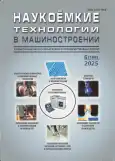TECHNOLOGICAL QUALITY ASSURANCE IN ROBOTIC FINISH BASED ON ADAPTATION TOOLS
- Authors: Vartanov M.V.1, Schwartz A.I.1, Mironov D.N.1
-
Affiliations:
- Moscow Polytechnic University
- Issue: No 6 (168) (2025)
- Pages: 31-39
- Section: Technological processes automated control
- URL: https://journal-vniispk.ru/2223-4608/article/view/303631
- DOI: https://doi.org/10.30987/2223-4608-2025-6-31-39
- ID: 303631
Cite item
Full Text
Abstract
About the authors
Mikhail Vladimirovich Vartanov
Moscow Polytechnic University
Email: natalia.vartanova@ba.ru
Aleksander Igorevich Schwartz
Moscow Polytechnic University
Dmitriy Nikolaevich Mironov
Moscow Polytechnic University
References
- Xiaolong Ke and ets. Review on robot-assisted pol-ishing: Status and future trends // Robotics and Computer-Integrated Manufacturing, 2023. https://doi.org/10.1016/j.rcim.2022.102482
- Fan Chen, Huan Zhao, Dingwei Li, Lin Chen, Chao Tan, Han Ding, Contact force control and vibration suppression in robotic polishing with a smart end effector // Robotics and Computer-Integrated Manufacturing, 2019. p. 391−403
- Gienke, O., Pan, Z., Yuan, L. et al. Mode coupling chatter prediction and avoidance in robotic machining pro-cess // Int. J. Adv. Manuf. Technol. 2019. p. 104. https://doi.org/10.1007/s00170-019-04053
- Schwarz A.I., Mironov D.N., Vartanov M.V. Methods of vibration suppression during robotic processing // STANKOINSTRUMENT, No. 3, (032), 2023. P. 34−41. https://doi.org/10.22184/2499-9407.2023.32.3.34.41
- Pan, Z. & Zhang, H. Robotic machining from pro-gramming to process control: a complete solution by force control // Industrial Robot, 2008. 35. No. 5. P. 400−409. https://doi.org/10.1108/01439910810893572
- J. Zhang, Y. Shi, X. Lin, Z. Li, Parameter optimi-zation of five-axis polishing using abrasive belt flap wheel for blisk blade // J. Mech. Sci. Technol31, 2017. 4805–4812. https://doi.org/10.1007/s00170-017-0717-z
- J. Pandremenos, C. Doukas, P. Stavropoulos, G. Chryssolouris Machining with robots: a critical review // 7th International Conference on Digital Enterprise Tech-nology. Athens. Greece. 2011.
- Cen, L., Melkote, S. N., Castle, J., and Appelman, H. A Method for Mode Coupling Chatter Detection and Suppression in Robotic Milling // ASME. J. Manuf. Sci. Eng., 2018. 140 (8). https://doi.org/10.1115/1.4040161
- Schneider, U., Drust, M., Ansaloni, M. et al. Im-proving robotic machining accuracy through experimental error investigation and modular compensation // Int. J. Adv. Manuf .Technol., 2016. p. 85, https://doi.org/10.1007/s00170014-.6021-2
- Tunc, L., Stoddart, D. Tool path pattern and feed direction selection in robotic milling for increased chatter-free material removal rate // Int J Adv Manuf Technol 89, 2017. P. 2907–2918. https://doi.org/10.1007/s00170-016-98962
- Wei Ji, Lihui Wang. Industrial robotic machin-ing: a review // The International Journal of Advanced Manufacturing Technology, 2019. P. 1239–1255, https://doi.org/10.1007/s00170-019-03403-z
- Russell Stewart, Norvig Peter. Artificial intelli-gence: a modern approach // Publishing house "Williams", 2016. P. 1408.
- Segreto T., Karam, S. & Teti, R. Signal pro-cessing and pattern recognition for surface roughness as-sessment in multiple sensors monitoring of robot-assisted polishing. // Int. J. Adv. Manuf. Technol. 90. 2017. P. 1023–1033 https://doi.org/10.1007/s00170-016-9463-x
- Khalick Mohammad A.E., Hong, J. & Wang, D. Polishing of uneven surfaces using industrial robots based on neural network and genetic algorithm. // Int. J. Adv. Manuf. Technol. 93, 1463–1471 (2017). https://doi.org/10.1007/s00170-017-0524-6
- Denavit, Jacques; Hartenberg, Richard Scheunemann A kinematic notation for lower-pair mecha-nisms based on matrices // Journal of Applied Mechanics. 22 (2), 1955, P. 215–221. https://doi.org/10.1115/1.4011045
Supplementary files









